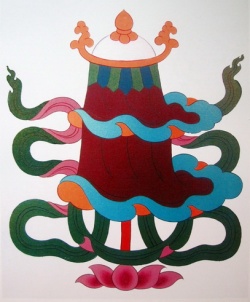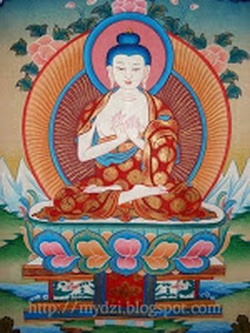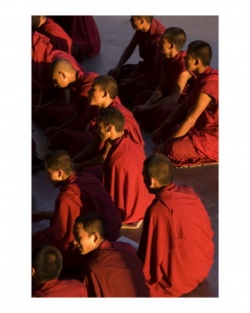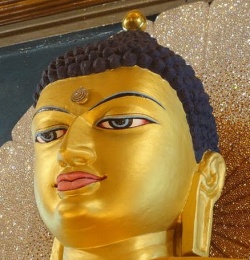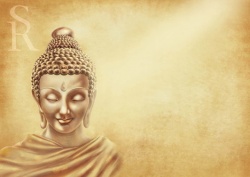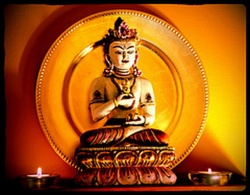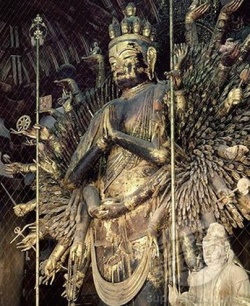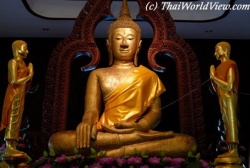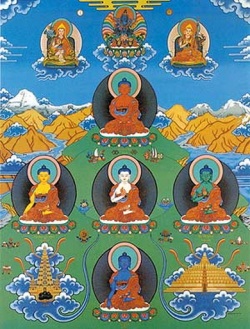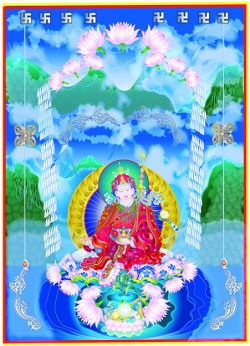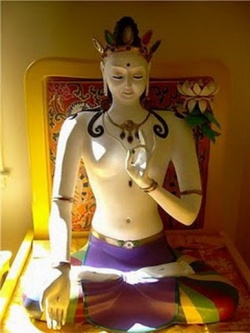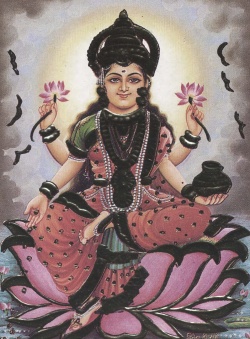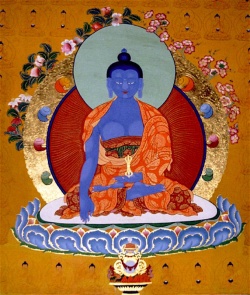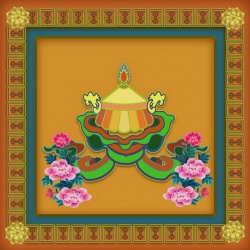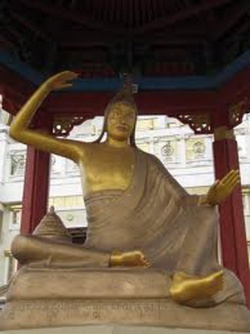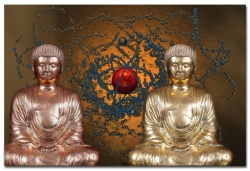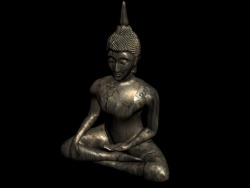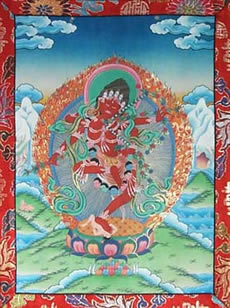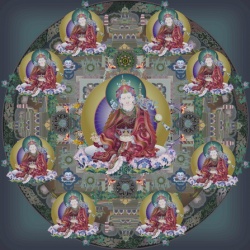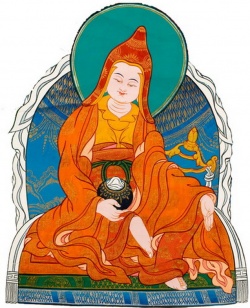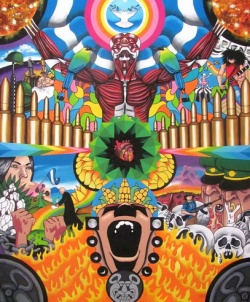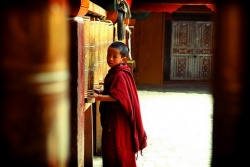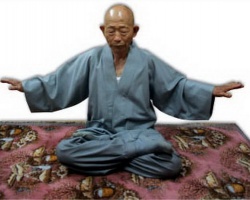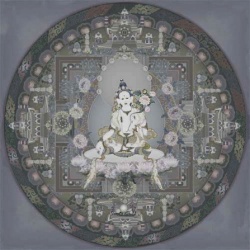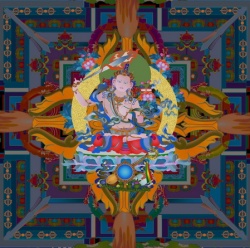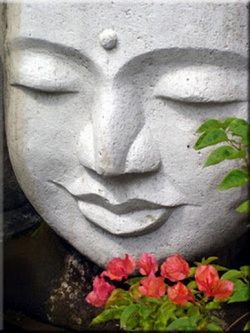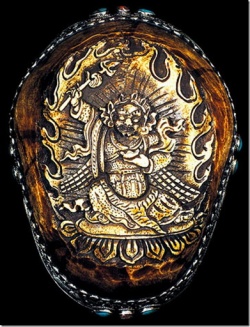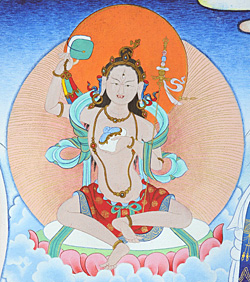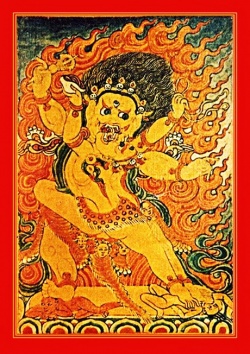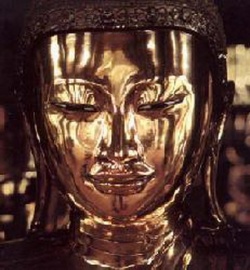The Dharma Flower Sutra seen through the Oral Transmission of Nichiren Daishōnin:The Seventeenth Chapter on Discerning the Meritorious Virtues
The Dharma Flower Sutra
seen through the Oral Transmission of
Nichiren Daishōnin
Thereupon, in the great assembly, on hearing the Buddha explain that his lifespan was infinite kalpas long, there were uncountable, boundless myriads of myriads of myriads of sentient beings who had been enriched by this (discourse).
Then the World Honoured One addressed Maitreya (Miroku), who was a completely evolved bodhisattva who had refused his own extinction into nirvana for the sake of the Buddha enlightenment of all sentient beings (bosatsu makasatsu, bodhisattva mahāsattva), saying: Invincible One, when I expounded the immeasurability of the lifespan of the Tathāgata, there were six hundred eighty myriads of myriads of myriads of times the grains of sand in the Ganges of sentient beings who had attained the patience through the Dharma to overcome all illusion and to bear all external hardships, on account of their fundamental belief in the indestructibility of the essence of life itself.
Again, there were a thousand times more completely evolved bodhisattvas who had refused their own extinction into nirvana for the sake of the Buddha enlightenment of all sentient beings, who could go through the gateway of and obtain tantric formulas that were able to lay hold of good so that it cannot be lost and likewise so that evil cannot arise (dhāranî) (so that they are able to retain what they have heard).
There were also other completely evolved bodhisattvas who had refused their own extinction into nirvana for the sake of the Buddha enlightenment of all sentient beings (bosatsu makasatsu, bodhisattva mahāsattva), whose number amounted to the particles of dust in a dimension of existence (world), who acquired the ability to explain the Dharma joyfully and without any hindrance due to not really knowing it.
Then, there were an equal number of bodhisattvas who had refused their own extinction into nirvana for the sake of the Buddha enlightenment of all sentient beings, who came into the possession of tantric formulas that were able to lay hold of good and that likewise, so that evil cannot arise, had hundreds of thousands of myriads of myriads of myriads of extensive powers of transformation.
Furthermore, there were as many fully evolved bodhisattvas who had refused their own extinction into nirvana for the sake of the Buddha enlightenment of all sentient beings (bosatsu makasatsu, bodhisattva mahāsattva) as the particles of dust in three thousand great thousands of dimensions of existence, who became able to turn the Wheel of the Dharma without ever turning back (to whatever they were before their conversion to the Buddha teaching).
Furthermore there were fully evolved bodhisattvas who had refused their own extinction into nirvana for the sake of the Buddha enlightenment of all sentient beings (bosatsu makasatsu, bodhisattva mahāsattva), whose number was equal to the particles of dust that make up two thousand times the middle kingdoms (Chū kokudo, Madhya Desha) (i.e., central northern India), who became capable of setting in motion the wheel of the perfectly immaculate Dharma.
There were likewise fully evolved bodhisattvas who had refused their own extinction into nirvana for the sake of the Buddha enlightenment of all sentient beings (bosatsu makasatsu, bodhisattva mahāsattva), whose number was equal to the particles of dust that would amount to a lesser thousand dimensions of existence (sekai), each with its Mount Sumeru, continents, seas, and a ring of iron mountains, who were able to attain the unexcelled, correct, and all-embracing enlightenment (anokutara sanmyaku sambodai, anuttara samyak sambodhi) in eight lifetimes.
Again, there were fully evolved bodhisattvas who had refused their own extinction into nirvana for the sake of the Buddha enlightenment of sentient beings (bosatsu makasatsu, bodhisattva mahāsattva) whose number amounted to four times the quantity of particles of dust that are the composition of the four continents of Mount Sumeru, who were able to realise the unexcelled, correct, and all-embracing enlightenment in four lifetimes.
Then, when the Buddha had disclosed the all-embracing benefits that the fully evolved bodhisattvas who had refused their own extinction into nirvana for the sake of the Buddha enlightenment of all sentient beings (bosatsu makasatsu, bodhisattva mahāsattva), had realised, it rained coral flowers and giant coral flowers from empty space, which were scattered over the uncountable hundreds of thousands of myriads of myriads of myriads of trees of precious materials and onto the Buddhas who were seated on their lion thrones underneath them. At the same time, these flowers wafted onto the Buddha Shākyamuni and the Tathāgata Abundant Treasure (Tahō Nyorai, Prabhūtaratna), who long ago had passed over to the extinction of nirvana and were both seated on the lion thrones in the stupa made of the seven precious materials (1) gold, 2) silver, 3) lapis lazuli, 4) crystal, 5) agate, 6) ruby, 7) cornelian).
In addition these coral flowers and giant coral flowers floated down onto the fully evolved bodhisattvas who had refused their extinction into nirvana for the sake of the Buddha enlightenment of all sentient beings (bosatsu makasatsu, bodhisattva mahāsattva) and even onto the assembly of monks, nuns, lay practitioners both male and female. Also, a fine powder of sandalwood sprinkled down, along with a shower of deeply scented water from the open sky. The drums of the deva (ten) resounded deeply with exquisite rhythms into the distance. Also, thousands of kinds of fabrics of the deva (ten) and various kinds of neckwear, necklaces of pearls, precious stones, and also wish-granting mani beads rained into all nine directions.
In all the incense burners there that were made of all sorts of precious materials, various kinds of incense smouldered that were beyond price. These incense burners spontaneously moved around the great assembly, as an offering to it. All the bodhisattvas held up banners and canopies over each and every Buddha, which progressively reached as far as the heavens of the Brahmanic deva (Bonten). With their sublime voices, all the bodhisattvas sang various anthems of exaltation, in praise of all the Buddhas.
Then the Bodhisattva Maitreya (Miroku) got up from his seat, uncovered his right shoulder, pressed the palms of his hands together, faced the Buddha with reverence, and declaimed the following metric hymn:
The Buddha explains
an exceptional Dharma
which has never been heard in the past.
The strength of the World Honoured One
is as incalculable as his lifespan.
Innumerable people
who hold faith in the Buddha teaching
heard the World Honoured One
expound in detail
all the benefits of the Dharma
that they were to obtain
and were completely filled with joy.
Some were able to dwell
on the terrain of never regressing.
Others obtained dhāranī (which are like mantras).
Some became able to expound the Dharma
happily and without hindrance.
Others obtained dhāranī
with myriads of myriads
of myriads of possibilities.
Or there were bodhisattvas,
whose number amounted to
as many particles of dust
as there are that comprise a great thousand
of dimensions of existence,
who were capable of setting in motion
the wheel of Dharma,
without ever turning back.
Again, there were bodhisattvas,
whose number amounted to
as many particles of dust
as there are that comprise
a medium-sized thousand
of dimensions of existence,
who became capable
of setting in motion the wheel
of the immaculately pure Dharma.
Furthermore, there were bodhisattvas,
whose number amounted to
the particles of dust that comprise
a single small thousand
of dimensions of existence,
who only had eight lifetimes to go
before they were to attain enlightenment.
Or even there were bodhisattvas,
whose number was to amount to as many
particles as there are that would comprise
four, three, or two Mount Sumerus
with their respective continents
who, in a corresponding count of lifetimes,
would attain the state of Buddhahood.
Then there were bodhisattvas,
whose number amounted to
the particles of dust that comprise
a single Mount Sumeru
with its corresponding four continents,
who only had one lifetime to go
before they would attain the wisdom
of the seekers who listen to the Buddha (shōmon, shrāvaka).
In this way, all sorts of sentient beings,
on hearing the unlimited lifespan
of the Buddha,
realised uncountable, pure, undefiled,
and immaculate fruitions,
as well as an inner awareness.
Also, there were sentient beings,
whose number was as many
as the particles of dust
that comprise eight realms of existence,
who on hearing the Buddha
expound his lifespan,
set their minds on the attainment
of the unexcelled, correct,
and all-embracing enlightenment.
The World Honoured One explains a Dharma
that cannot be conceived or discussed,
which assures particular
inner realisations
like the boundlessness of empty space.
Then it rains coral tree flowers,
as many as the sands of the Ganges,
or the number of Taishaku (Indra),
or the Bonten (Brahmanic deva).
Then countless Buddha dimensions arrive
that bring about a rain
of sandalwood powder
and water steeped in scent,
which all fall mixed together
and in disorder,
just like a flock of birds
that come down from the sky,
as a scattered offering to the Buddha.
In the middle of empty space,
the drums of the deva (ten)
spontaneously resound
with exquisite rhythms.
Ten thousand kinds
of celestial fabrics
come spinning round towards the ground.
All the incense burners, which are made
of splendidly precious materials,
burn various kinds of incense beyond price,
that on their own, make a complete tour
of the whole assembly,
as an offering
to all the World Honoured Ones.
All the great multitude of bodhisattvas
are holding banners and canopies
that are made
of seven precious materials (1) gold, 2) silver, 3) lapis lazuli, 4) crystal, 5) agate, 6) ruby, 7) cornelian)
that are large, marvellous,
and of myriads of myriads
of varieties,
which progressively reach up
to the heaven of the Bonten (Brahmanic deva).
In front of each one of the Buddhas,
there are flagstaffs of precious materials,
upon which hang superlative banners.
The bodhisattvas, with thousands
of myriads of metric hymns,
sing their praises to all the Tathāgatas.
Such a variety of happenings
have never been seen before.
On hearing of the boundless lifespan
of the Tathāgata,
everybody was filled with joy (because in spite of life’s vicissitudes, it can never be destroyed).
The renown of the Buddha
has reached all ten directions
and broadly benefitted
sentient beings,
who all found a basis of goodness (zengon, kushala-mūla) (absence of greed, absence of hatred, and an absence of stupidity)
which became the auxiliaries
of the highest aspirations of their minds.
Then the Buddha addressed the completely evolved bodhisattva who had refused his own extinction into nirvana for the sake of the Buddha enlightenment of all sentient beings, Maitreya (Miroku), saying: Invincible One, if there are sentient beings who, on hearing that the lifespan of the Buddha is of such a far-reaching eternity, in an instant of faith are able to understand it, then the meritorious virtues (kūdoku, guna) are the benefits they receive, which will be beyond any limit or measure.
The first important point, on the sentence, “Then the Buddha addressed the completely evolved bodhisattva who had refused his own extinction into nirvana for the sake of the Buddha enlightenment of all sentient beings, Maitreya (Miroku), saying: Invincible One, if there are sentient beings who, on hearing that the lifespan of the Buddha is of such a far-reaching eternity, in an instant of faith are able to understand it, then the meritorious virtues are the benefits they receive, which will be beyond any limit or measure.”
The Oral Transmission on the Meaning of the Dharma Flower Sutra (Ongi Kuden) says that the word “faith” as in the above phrase, “in an instant of faith are able to understand it”, is the innate cause of the accession to all the wisdom and discernment of the enlightened. The single word “faith” is comprehension of the fundamental title and theme of the Buddha teaching (i.e., Nam Myōhō Renge Kyō), and those who only hear it and hold faith in it are within the Dharma of enlightenment and are potentially Buddhas. As a result, this single word “faith” is the sharp sword that cuts us loose from our inherent unenlightenment (of our not wanting to know what existence is about).
The word “faith” means to hold faith in the principle that all sentient beings are able to show to themselves evidence of their own original archetypal state, as it is expounded in the Chapter on the Lifespan of the Tathāgata. “To understand” means to understand the implications of the pragmatic manifestation of the original archetypal state, in terms of the Fundamental Object of Veneration (gohonzon). Both the pragmatic and speculative (i.e., in principle) manifestations of the original archetypal state are contained in the single instant of faith that leads to our understanding of the two. A single instant is comprised of the one timelessness that has always existed and will continue to exist into eternity.
People who have such a faith and understanding have effective merits and benefits that are beyond any limit or measure. Where there is faith, there is understanding, and where there is understanding, there is faith. However, it is on account of our faith that it is made absolutely certain that we will open up our inherent Buddha nature, with our persons just as they are. Now, Nichiren and those that follow him reverently recite Nam Myōhō Renge Kyō which means to devote our lives to and found them on (Nam(u)) the Utterness of the Dharma (Myōhō) (entirety of existence) permeated by the underlying white lotus flower-like mechanism of the interdependence of cause, concomitancy and effect (Renge) in its whereabouts of the ten (psychological) realms of dharmas (Kyō).
If there are believing and convinced men and women who, with the intention of attaining the unexcelled, correct, and all-embracing enlightenment, were to practise for a period of eight myriads of myriads of myriads of kalpas and who were to carry out five of the six virtues that ferry people from the shore of births and deaths to the other shore of nirvana of perfection – dānapāramitā (1) charity including teaching the Buddha truth to others), shilapāramitā (2) keeping to the commandments of the monastic order), kshantipāramitā (3) patience under insult and abuse), viryapāramitā (4) diligent progress), dhyānapāramitā (5) meditative concentration), prajñāpāramitā (6) wisdom, the ability to discern what reality is and the truth of existence, this last virtue being what actually carries us across the sea of living and dying to the shore of nirvana) – if one were to compare the merits to the preceding merits, then they would not come up to a hundredth, nor a thousandth, nor even a myriadth of a myriadth of a myriadth, to a point that no calculation nor any comparison could ever be known.
If there is such a believing and convinced person who has such merits and were to regress from trying to attain the unexcelled, correct, and all-embracing enlightenment, then such a concept could exist.
There and then, the World Honoured One, wishing to reiterate the significance of what he had said, expressed it in the form of a metric hymn.
If there are persons
who would seek the Buddha wisdom
over a period
of eighty myriads
of myriads of kalpas,
who were to practise five of the virtues
that ferry people
across the seas of living and dying
to the shore of nirvana (haramitsu, pāramitā)
and during all these kalpas,
were to make offerings to the Buddhas,
to those people
who are partially enlightened
due to a profound search
for the meaning of existence (engaku, hyakushibutsu, pratyekabuddha),
as well as their disciples,
and to all the bodhisattvas,
of delicious and rare dishes,
as well as libations
that are a delight to the palate,
and of the best of garments and bed clothing,
and, at the same time,
were to build them palaces,
for pure or spiritual cultivation,
out of sandalwood,
that would be surrounded
by gardens and little woods –
such offerings,
all of which are sensitively marvellous
in their variety –
if such people
were to pass the entirety
of this number of kalpas
dedicating themselves
to the path of Buddhahood,
and if they were to keep the precepts
of the clerical community (sō, sangha)
in all purity and never slipping up,
then with regard to their search
for the unsurpassed path
which is exalted by all the Buddhas,
and if such people practise patience,
abiding in a dimension
that is gentle and moderate,
even when perverted beings
come to do harm,
the minds of the practitioners,
never deviate nor are shaken up.
When all these people
who claim to have understood the Dharma
are filled with a haughtiness beyond measure
that makes them jibe at and despise
the real practitioners
who are again capable
of taking such treatment with patience,
then if such practitioners
are determined to make progress
and are always firmly resolved,
over a period of myriads
of myriads of myriads of kalpas,
without neglecting their practice
or getting tired,
and again, for countless kalpas
they dwell in deserted places,
either seated, or walking around
avoiding sleep,
and continually controlling their thoughts,
on account of such causes
and concomitancies,
they are able to give rise to
and concentrate on
a single object of meditation,
so that during eighty myriads
of myriads of myriads of kalpas
they abide steadily,
with their thinking undisturbed.
Holding on to happiness
with the whole of their minds,
they aspire to seek
the unsurpassed path to enlightenment.
“I will attain
the highest stage of the teachings
of the individual vehicle (shōjō, hīnayāna)
and become an arhat (issaichi).
I will bring all
the meditative concentrations
on a single point to their utmost limits (zenjō).”
Over a period of a hundred
thousands of myriads of myriads
of myriads of kalpas,
such people practise all these goodnesses
just as I have described.
All you believing
and convinced men and women
who have heard and believed my discourse
on the infinity of my lifespan,
then all these people will be
entirely without doubts or regrets
and enjoy a happiness beyond bound,
in the depths of their minds,
and realise a gladness
as I have described it.
All these bodhisattvas
who for innumerable kalpas
have practised on the path of enlightenment,
on hearing me explain what my lifespan is,
are able to accept what I say with faith.
All such people
will accept this sutra with reverence.
The second important point regarding the last section of the above metric hymn: “All these bodhisattvas who for innumerable kalpas have practised on the path of enlightenment, on hearing me explain what my lifespan is, are able to accept what I say with faith. All such people will accept this sutra with reverence.”
The Oral Transmission on the Meaning of the Dharma Flower Sutra (Ongi Kuden) says this is clearly the text that explains how we should accept this sutra, with veneration and awe. The above words, “all such people”, in the broadest sense are extended to all sentient beings. Hence, all the Buddhas of the past, present, and future of all the ten directions, through accepting the Dharma Flower Sutra (Hokke-kyō) with veneration and awe, were able to attain to the state of Buddhahood.
Consequently, with reference to the title of the preceding Chapter on the Lifespan of the Tathāgata, I have emphasized the title by adding Nam Myōhō Renge Kyō, headed by the honorific “Tathāgata” (see the first important point of The Oral Transmission on the Meaning of the Dharma Flower Sutra (Ongi Kuden) of the Sixteenth Chapter). This is an esoteric teaching and should be kept secret.
Now, this is the reason why Nichiren and those that follow him reverently recite Nam Myōhō Renge Kyō, which means to devote our lives to and found them on (Nam(u)) the Utterness of the Dharma (Myōhō) (entirety of existence) permeated by the underlying white lotus flower-like mechanism of the interdependence of cause, concomitancy and effect (Renge) in its whereabouts of the ten (psychological) realms of dharmas (Kyō).
Could it be in future ages
that, on account of our protracted lifespans,
we will be able
to ferry sentient beings
from the shores of living and dying
to the shore of nirvana,
in the same way as the World Honoured One
who as sovereign among the Shakya clan,
at the place of enlightenment (i.e., under the bodhi tree)
pronounced the lion’s roar of victory
and expounded the Dharma
without hesitation?
May we, in dimensions of the future,
be venerated and respected by all?
When we are seated
at the place of enlightenment,
may we explain the infinity
of our existence in the same manner?
If there are people
whose thinking runs very deep,
whose personalities are correct
and immaculately pure,
who are learned
and able to remember everything,
as well as understanding
the terminology
of the Buddha teaching
and what these terms mean,
if such people were to hear
of the infinity
of the Buddha’s lifespan,
they would not be held back by any doubts.
Once again, Maitreya (Miroku), O Invincible One, if there are any who, on hearing the infinity of the lifespan of the Buddha, were to understand the meaning of what he was saying, the merits that such persons would obtain would be without limit or measure. They would be able to give rise to the unsurpassable wisdom of the Tathāgata.
Why should this be so?
Any persons who were to hear this sutra in its entirety or to get someone else to listen to it, or to hold to it for themselves or to get someone else to hold to it, or write it out for themselves or have it copied out by someone else, or even were to make offerings to its scrolls of flowers, of incense or garlands, of banners on flagpoles, of canopies of silken fabrics, of scented oils or fragrant lamps, the merits of such people would be boundless beyond any limit. They would be able to attain the wisdom of the Buddhas, which is capable of attaining enlightenment as to every aspect of existence (issai-shu-chi, sarvatta-jñāna).
O Invincible One, if there are convinced and believing men or women, who were to hear me explain the infinity of my lifespan and were to believe and understand it in the depths of their minds, they will see the Buddha eternally on Spirit Vulture Peak (Ryōjusen, Gridhrakūta), surrounded by the assembly of bodhisattvas and people who exert themselves to attain the highest stage of the teachings of the individual vehicle (shōjō, hīnayāna) through listening to the Buddha (shōmon, shrāvaka).
They will still see the Dimension we have to Endure (shaba sekai, sahā-lokadhātu), but the ground will be of lapis lazuli and unvaryingly flat. The borders of the eight roads that are spread out like the spokes of a wheel will be marked out by powdered gold from the river Jambū and flanked by trees of precious substances. Also the terraces, stately mansions, and towers will be built of materials that are precious. These will be inhabited by the assembly of bodhisattvas. If there are people who can look upon and discern the world in this way, then you should know it is a sign of the depth of their faith and understanding.
Again, after the Tathāgata’s passing over to the extinction of nirvana, if someone were to listen to this sutra, without destructively making fun of it or speaking ill of it, and through hearing it be filled with joy, then this is already evidence of the profound faith and insight of that person, not to mention those people who were to read and recite it and who were to accept and hold to it. Such people will be particularly favoured by the Tathāgata.
O Invincible One, these convinced and believing men and women will, among other things, have no need to construct stupas or temples for my sake; nor will they have to build living quarters for the clerical community (sō, sangha); nor will there be any need for them to make an offering of the four necessaries of the religious order (1) victuals, 2) clothing, 3) bedding, 4) medicine).
What is the reason for this?
All these believing, convinced men and women, on their acceptance of and holding to this sutra, their reading and recitation of it, have already built a stupa and quarters for the clerical community (sō, sangha), as well as having made offerings to it.
What those people have to do is to build a stupa for the relics of the Buddha with the seven precious materials (1) gold, 2) silver, 3) lapis lazuli, 4) crystal, 5) agate, 6) ruby, 7) cornelian) that has a broad base that will gradually get narrower and will finally reach the heavens of the Brahmanic deva (Bonten) on which there will be hung all sorts of banners, canopies, and priceless bells. This stupa is also to be adorned with scent from flowers, garlands, fragrant unguents, powdered scents, and incense that is to be burned, as well as being venerated with the sounds of drums, various kinds of musical instruments, such as flutes and harps, that are to be accompanied by a variety of dances, also singing with exceptional voices, hymns, and songs of praise. These offerings will have to be prolonged, until innumerable thousands of myriads of myriads of myriads of kalpas have passed.
O Invincible One, if after my extinction into nirvana there are people who will listen to this sutra and find that they can accept and hold to it, if they were to write it out themselves or get someone else to copy it, or they were to build living quarters for the clerical community (sō, sangha), or if they were to construct out of red sandalwood thirty-two palaces as tall as eight fan palms, whose bases were dignified, tall, and elegant, which were able to accommodate a hundred thousand monks, with gardens and woodlands, pools to bathe in and ponds, footpaths, caves for meditation – where they would be furnished with clothing, food and drink, beds and bed covering, medicinal potions, along with various kinds of musical instruments – such edifices that are to be inhabited by the clerical community (sō, sangha) or such pavilions should be several hundreds of thousands of myriads of myriads of myriads of buildings, whose actual number cannot be calculated. All these structures will be given as offerings to myself as well as the community of monks (biku, bhikshu).
This is why I explain that after my extinction into nirvana, if there are any who accept and hold to, read and recite this sutra, as well as expounding it to other people, or even if these persons write it out themselves or get someone else to copy it, or at the same time make offerings to it, again, it will not be necessary for such persons to build stupas or temples or construct living quarters for the clerical community (sō, sangha) or make offering to the monastic order.
By the same token, if there are persons who are really capable of holding to this sutra, as well as doing the practices that ferry people over the seas of living and dying to the shore of nirvana, and carry out single-mindedly the observances of charity, holding to the monastic precepts, having patience when they are under provocation, making progress diligently, as well as showing wisdom and discernment, such merits are most eminent and excellent, unlimited, and without bounds.
For example, all the empty space from east to west, south to north, also the four intervening quarter directions, as well as all the empty space that exists above and below, is incomparable and infinitely huge. In the same way the deserving qualities and merits of such people are identical, and they will soon arrive at the wisdom of the Buddha, they will in this way obtain good and meritorious virtues.
If there are people who are reading and reciting this sutra, as well as accepting it and holding to it and also explain it to other people, who either write it out themselves or get other people to copy it, or again are able to build stupas or living quarters for the clerical community (sō, sangha), or to make offerings, as well as praising the congregation of the people who exert themselves to attain the highest stage of the teachings of the individual vehicle (shōjō, hīnayāna) through listening to the Buddha (shōmon, shrāvaka), they will in this way obtain good and meritorious virtues.
Or if, by means of hundreds of thousands of myriads of myriads of myriads of hymns of praise, they celebrate the merits of the bodhisattvas, or again, for the benefit of other people and by means of citing various causes and karmic circumstances, they can explain the meaning of the Dharma Flower Sutra (Hokke-kyō), or again are able to hold to the immaculately pure monastic precepts and are able to live alongside meek and gentle people, be patient and devoid of anger, as well as being firm in their personal resolution to attain enlightenment, who always cherish sitting and fixing their thoughts on a single object of meditation (zazen), so as to obtain various kinds of perfect absorptions of their thoughts into particular concepts for introspection, who will make audacious and diligent progress, so as to be able to take in the good Dharma with wisdom, discernment, and a keen mind that is capable of understanding the subtle teachings of the Buddha, as well as being able to answer difficult questions – O Invincible One, if after my extinction into nirvana there are convinced and believing men and women who hold to this sutra by reading and reciting it, they will in this way obtain good and meritorious virtues. You should know that these people are already facing in the direction of the place where the path of Buddhahood is realised and are close to the point of attainment of the unexcelled, correct, and all-embracing enlightenment (anokutara sanmyaku sambodai, anuttara samyak sambodhi) and will soon be seated at the base of the bodhi tree.
O Invincible One, for all these believing men and women, if they are sitting, standing upright, or walking about, it would be better to erect a stupa at the place where they are practising, so that all the deva (ten) and humankind can make offerings to it, as though it were the stupa of the Buddha.
Thereupon the World Honoured One, wising to reiterate the significance of what he had expounded, expressed it in the form of a metric hymn.
For those who
after my extinction into nirvana
can reverently hold to this sutra,
the happiness of these people
will be boundless.
In the same way
as I have explained it just now,
all these merits will amount to
the total of the offerings
of erecting a stupa
for the relics of the Buddha
that is adorned
with the seven precious materials (1) gold, 2) silver, 3) lapis lazuli, 4) crystal, 5) agate, 6) ruby, 7) cornelian),
that looks like a funerary pyre,
which is very tall
and extremely broad at the base,
whose extremity becomes narrower
and reaches the heaven
of the Brahmanic deva (Bonten),
adorned with thousands of myriads
of myriads of myriads of bells
made of precious substances,
which, when they are resonated by the wind,
make sublime sounds.
For boundless kalpas,
people will make offerings to this stupa
of flowers, incense,
and varying sorts of garlands,
as well as fabrics of the deva (ten),
and different kinds of music,
perfumed oils for burning and lamps of ghee,
which will continuously shine all around.
But those who can hold to this sutra,
during the iniquitous age
at the end of the Dharma,
as it already
has been said previously,
will be seen as those
who have made all these offerings.
If there is anyone
who can hold to this sutra,
it will be
in terms of the reality
of the Buddha,
the same as having built
with ox-head sandalwood
living quarters
for the clerical community (sō, sangha)
as an offering,
that would amount to
thirty-two palatial dwellings
as high as eight fan palms,
also offerings of excellent dishes
and sublime fabrics,
as well as beds
completely furnished with bedclothes.
The clergy will live
in hundreds of thousands of communities
with woodlands, gardens, pools and ponds,
paths for taking walks,
and caves for meditation,
all dignified and elegant
in their variety.
If there is a person
with a mind of faith and understanding
who accepts and holds to this sutra,
reading it and reciting it,
as well as writing it out,
or who has it copied by somebody else,
or makes offerings to its sutric scrolls,
by scattering upon them flowers,
incense, and perfumed powders,
and impregnating them
with the smell of jasmine, gardenias,
mango tree flowers, and hemp,
by continually burning oils
infused with these scents –
people who make such offerings
will have boundless merits,
as vast as the emptiness of space,
and their happiness will be likewise.
Furthermore, for those who hold to this sutra,
as well as carrying out
the practice of charity,
holding to the monastic precepts,
forbearance under provocation,
as well as having an appreciation
of meditating on a single object (zenjō),
without ever using verbal abuse
or getting angry,
and who show reverence
to stupas and temples,
as well as showing a humble attitude
towards other monks,
and are completely free
from arrogant thinking,
whose minds are directed towards wisdom,
never getting irritated
by difficult questions,
so as to answer them
in an appropriate manner,
their merits will be incalculable.
If such a master of the Dharma
has accomplished virtues such as these,
then he should be showered
with flowers of the deva (ten)
and clothed with the garments of the gods.
One should bow to his feet in reverence
and look upon this person as a Buddha.
Again, one should bear this in mind,
that such practitioners will soon arrive
at the place of enlightenment
at the base of the bodhi tree
and will reach the stage of being
without any troublesome worries (bonnō, klesha)
whatsoever,
so that their minds are not subject
to cause, conditioning, dependence,
and are free from the senses,
eternal, inactive,
and as pure as the nature of the Dharma (or Myōhō Renge Kyō)
that will bring about vast benefits
to the deva (ten) and humankind.
Wherever these practitioners abide,
whether these people
are walking around in contemplation,
or whether they are lying down,
even though they have not yet
uttered a single metric hymn,
it would be better to construct a stupa
at such a place
and make it superbly elegant,
as well as making offerings to it,
when such places are where
the faithful believers of the Buddha dwell,
and their Buddhahood accepts them,
so that they can function
as enlightened people.
The third important point, on the phrase, “when such places are where the faithful believers of the Buddha dwell, and their Buddhahood accepts them, so that they can function as enlightened people”.
The Oral Transmission on the Meaning of the Dharma Flower Sutra (Ongi Kuden) states that the passage in the above metric hymn is a cross-reference that points to the entity of enlightened wisdom that is spontaneously and freely received (or accepted), as a means of salvation for all sentient beings (or, as it is sometimes expressed, as the Buddha who derives a limitless joy from the Utterness of the Dharma (Myōhō, Saddharma) or the Buddha of absolute freedom).
The words “such places” refer to the ground upon which the triple entity of the Buddha depends for an existence (i.e., 1) the entity of the Dharma which is the highest aspect of the threefold identity of the Buddha and is the absolute nature of the Buddha mind, 2) the entity of the wisdom of the Dharma, 3) the manifestation of this Buddhahood, as it appears for the benefit of unenlightened sentient beings such as us).
The faithful believers are the practitioners of the Dharma Flower Sutra (Hokke-kyō). These practitioners are bodhisattvas; and, at the same time, the practitioner of the Dharma Flower Sutra (Hokke-kyō) is one who not only is enlightened for himself but strives for the enlightenment of others (bosatsu, bodhisattva).
In this sutric text, the verb “to dwell” implies a faith that leads to a complete understanding. Now, Nichiren and those that follow him reverently recite Nam Myōhō Renge Kyō which means to devote our lives to and found them on (Nam(u)) the Utterness of the Dharma (Myōhō) (entirety of existence) permeated by the underlying white lotus flower-like mechanism of the interdependence of cause, concomitancy and effect (Renge) in its whereabouts of the ten (psychological) realms of dharmas (Kyō), and are people who dwell on the ground of the Utterness of the Dharma (Myōhō, Saddharma).
Also, they are people who are received and used by the fundamental Buddhahood, as a means of salvation for all sentient beings. You should ponder over the meaning of this very deeply.
Buddhahood is eternally in their midst,
whether they are walking around
in contemplation,
or even sitting, or lying down.
Continue Reading
- The Dharma Flower Sutra seen through the Oral Transmission of Nichiren Daishōnin: Preface
- The Dharma Flower Sutra seen through the Oral Transmission of Nichiren Daishōnin: Synopsis of the Dharma Flower Sutra (Hokke-kyō) Trilogy
- The Dharma Flower Sutra seen through the Oral Transmission of Nichiren Daishōnin: The First and Introductory Chapter
- The Dharma Flower Sutra seen through the Oral Transmission of Nichiren Daishōnin: The Second Chapter on Expedient Means
- The Dharma Flower Sutra seen through the Oral Transmission of Nichiren Daishōnin: The Third Chapter on Similes and Parables
- The Dharma Flower Sutra seen through the Oral Transmission of Nichiren Daishōnin: The Fourth Chapter on Faith Leading to Understanding
- The Dharma Flower Sutra seen through the Oral Transmission of Nichiren Daishōnin: The Fifth Chapter on The Parable of the Medicinal Herbs
- The Dharma Flower Sutra seen through the Oral Transmission of Nichiren Daishōnin: The Sixth Chapter on The Disclosure of the Future Record Of those who will attain Enlightenment
- The Dharma Flower Sutra seen through the Oral Transmission of Nichiren Daishōnin: The Seventh Chapter on The Parable of the Imaginary City
- The Dharma Flower Sutra seen through the Oral Transmission of Nichiren Daishōnin: The Eighth Chapter on the Prediction of Enlightenment for Five Hundred Disciples
- The Dharma Flower Sutra seen through the Oral Transmission of Nichiren Daishōnin: The Ninth Chapter on the Announcement of the Future Attainment to Buddhahood of Both Those who Need and Do Not Need Instruction
- The Dharma Flower Sutra seen through the Oral Transmission of Nichiren Daishōnin: The Tenth Chapter on The Dharma as a Teacher
- The Dharma Flower Sutra seen through the Oral Transmission of Nichiren Daishōnin: The Eleventh Chapter on Seeing the Vision of the Stupa made of Precious Materials
- The Dharma Flower Sutra seen through the Oral Transmission of Nichiren Daishōnin:The Twelfth Chapter on Daibadatta (Devadatta)
- The Dharma Flower Sutra seen through the Oral Transmission of Nichiren Daishōnin:The Thirteenth Chapter on Exhorting the Disciples to Receive and Hold to the Buddha Teaching
- The Dharma Flower Sutra seen through the Oral Transmission of Nichiren Daishōnin:The Fourteenth Chapter on Practising in Peace and with Joy
- The Dharma Flower Sutra seen through the Oral Transmission of Nichiren Daishōnin:The Fifteenth Chapter on the Bodhisattvas who Swarm up Out of the Earth
- The Dharma Flower Sutra seen through the Oral Transmission of Nichiren Daishōnin:The Sixteenth Chapter on the Lifespan of the Tathāgata
- The Dharma Flower Sutra seen through the Oral Transmission of Nichiren Daishōnin:The Seventeenth Chapter on Discerning the Meritorious Virtues
- The Dharma Flower Sutra seen through the Oral Transmission of Nichiren Daishōnin:The Eighteenth Chapter on the Joy of the following Meritorious Virtues of Practice
- The Dharma Flower Sutra seen through the Oral Transmission of Nichiren Daishōnin:The Nineteenth Chapter on the Meritorious Virtues of the Teacher who Propagates the Dharma Flower Sutra
- The Dharma Flower Sutra seen through the Oral Transmission of Nichiren Daishōnin: The Twentieth Chapter on the Bodhisattva Not Holding Anyone or Anything in Contempt Ever (Jōfukyō, Sadapāribbhūta)
- The Dharma Flower Sutra seen through the Oral Transmission of Nichiren Daishōnin: The Twenty-first Chapter on the Reaches of the Mind of the Tathāgata
- The Dharma Flower Sutra seen through the Oral Transmission of Nichiren Daishōnin: The Twenty-second Chapter on the Assignment of the Mission
- The Dharma Flower Sutra seen through the Oral Transmission of Nichiren Daishōnin: The Twenty-third Chapter on the Original Conduct of the Bodhisattva Sovereign Medicine (Yaku’ ō, Bhaishajya-rāja)
- The Dharma Flower Sutra seen through the Oral Transmission of Nichiren Daishōnin: The Twenty-fourth Chapter on the Bodhisattva Sound of Utterness (Myo ‘on, Gadgadasvara)
- The Dharma Flower Sutra seen through the Oral Transmission of Nichiren Daishōnin: The Twenty-fifth Chapter on the Universal Gateway of the Bodhisattva Perceiving the Sound of the Existential Dimensions (Kanzeon, Avalokiteshvara)
- The Dharma Flower Sutra seen through the Oral Transmission of Nichiren Daishōnin: The Twenty-sixth Chapter on Dhāranī
- The Dharma Flower Sutra seen through the Oral Transmission of Nichiren Daishōnin: The Twenty-seventh Chapter on the Original Conduct of King Utterly Embellished (Myōshōgonnō, Shubhavyūha)
- The Dharma Flower Sutra seen through the Oral Transmission of Nichiren Daishōnin: The Twenty-eighth Chapter on the Persuasiveness and Quest (for Buddhahood) of the Bodhisattva Universally Worthy (Samantabhadra, Fugen)
